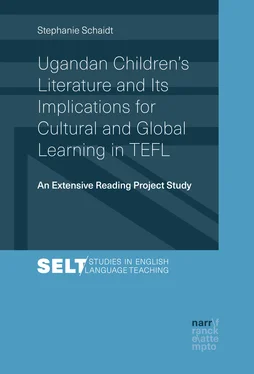1 ...6 7 8 10 11 12 ...34
2.6 Constructivist Approaches to Understanding Otherness
Since constructivist approaches to understanding otherness are considered to play an important role in the context of transcultural learning (see Eckert & Wendt, 2003a; Fäcke, 2006), they require further explanation at this point. Constructivism is an epistemological theory grounded in the school of scepticism and drawing on neurobiological research (Maturana & Varela, 1987). There are different varieties of constructivism; whereas advocates of radical constructivism (Glasersfeld, 1989, 1995) negate the existence of any “objective reality independent of human mental activities” (Müller, 2000, p. 45), moderate constructivists “believe in the existence of a real world which cannot be ‘objectively’ experienced or represented because our mind will us always give mere ‘interpretations’ or ‘mental models’ of this reality” (ibid.). Representatives of social constructivism (Frindte, 1998; Hejl, 1992; Vygotsky, 1978, 1980) describe the construction of knowledge as a result of social interaction in contexts.
From the 1990s on, constructivist approaches have increasingly gained in importance also in foreign language didactics. Michael Wendt (1993, 1996, 1998, 2000, 2002) argues from a radical constructivist perspective. He holds the view that the subject constructs its subjective realities and that an objective reality does not exist because of the self-referentiality of the brain. For him learning is the construction and ‘viabilisation’1 of hypotheses. Perturbations2 are considered productive in the learning process as they trigger new mental constructions (2002, pp. 9–13). Radical constructivism has aroused strong opposition. It has been criticised, for example, by Nüse et al. (Nüse & Groeben, 1995, pp. 251–252), Bredella (1998, p. 39) and Reinfried (1999) for its principle of self-referentiality of knowledge. If it is systematically applied, they argue, this would also lead to the questioning of radical constructivism itself.
Dieter Wolff (1990, 1994, 1997, 2002a, 2002b) brings ideas of a rather moderate constructivism to foreign language teaching. He bases his line of argument on the assumption that knowledge is constructed in the interaction between prior knowledge (schemata) and influences from the environment (stimuli) (2002, pp. 35–71). The way he deals with the term ‘construction’ he describes as “ pragmatisch [pragmatic]” (2002b, p. 182), meaning that for him the recognition of reality is possible, although it is always an individual process. Whereas in radical constructivism the focus is solely on the subject, and contexts are merely taken into account, Wolff considers that the social context also plays an important role in the meaning creation process of individuals:
Neues Wissen impliziert die Umstrukturierung bereits vorhandenen Wissens. Der soziale Kontext, die soziale Interaktion sind (insofern) beim Lernenden von ausschlaggebender Bedeutung. [New knowledge implicates the restructuring of prior knowledge. The social context, the social interaction is (in this respect) of decisive importance for the learner.] (1997, p. 107; my translation)
Wolff’s approach faced disapproval as well; particularly his postulate of the obsoleteness of instruction has been criticised (Reinfried, 1999).
It becomes apparent that there are major differences concerning the theoretical background of the two approaches, both come, however, to similar conclusions for learning and teaching practice. According to constructivists in general, ‘meaning’ is created and it is “subjective and non transferable [sic]” (Müller, 2000, p. 45). Consequently, they see learning as a process which is autonomous and active. Thus, constructivist learning theories pay tribute to individual differences of learners and suggest holistic approaches to teaching and learning that allow each learner to construct her/his own ‘reality’. Key principles of teaching and learning that are based on constructivism are learner autonomy and rich learning environments. The teacher acts as a facilitator, not an instructor, in the constructivist classroom (ibid., p. 46).
In the field of cultural learning, constructivist approaches to understanding otherness evolved in critical response to Fremdverstehen . Representatives of constructivist approaches to learning, radical constructivism (Eckerth & Wendt, 2003a; Wendt, 1993) and deconstructivism (Fäcke, 2006), doubt that it is possible to take an inner perspective on another culture.3 They regard the perspective on self as something very complex and always influenced by personal experiences, interpretations, emotions and are of the opinion that this applies even more for perspectives on others. Knowledge about reality is constructed through ‘viabilisation’ (see footnote 7). When different constructions of reality are incompatible, something appears as foreign:
Fremdheit läßt sich demzufolge als Inkompatibilität der Wirklichkeitskonstruktionen verschiedener Individuen definieren. Sobald Inkompabilität festgestellt ist, bleiben grundsätzlich zwei Möglichkeiten: Man kann den Fremden zur ungeeigneten Instanz für die eigenen Viabilitätsprüfungen erklären oder ihn zum “Anlaß” nehmen, die eigenen Wirklichkeitskonstruktionen zu revidieren. [Foreignness can therefore be described as an incompatibility between constructions of reality of different individuals. As soon as incompatibility is observed, there are generally two possibilities: the foreign can be considered as inappropriate for one’s own viabilisation process or as a trigger to revise one’s own construction of reality.] (Wendt, 1993, p. 47; my translation)
Foreignness can only be overcome to the degree to which the person is willing and able to viabilise her/his constructions of reality. This is usually a life-long process. Mutual viabilisation is considered both a prerequisite and an aim of any social and linguistic interaction (Eckerth & Wendt, 2003a, p. 13).
According to Fäcke (2002, p. 214), constructivist approaches to otherness may help to reduce the danger of appropriation. The hermeneutic distance (see Hunfeld, Chapter 2.3) is maintained and used as a starting point for critical reflections:
Vor diesem Hintergrund bedeutet interkulturelles Lernen die Fähigkeit und die Offenheit, eigene Wirklichkeitskonstruktionen nicht nur auf individueller Ebene innerhalb der Eigengruppe, sondern auch durch fremdkulturelle Gruppen zu viabilisieren. Dies bedeutet eine Form der Fremdsozialisation, die ohne Aneignungen auskommen kann, indem prinzipiell ein Moment des Nicht-Verstehens bzw. Eigenartigen mitgedacht wird (vgl. Wendt 2000). [Against this background intercultural learning is the ability and openness to viabilise your own constructions of reality not only on an individual level within your own group but also through foreign groups. This implies a kind of socialisation into the foreign (culture) which can proceed without appropriation, by always including an element of non-understanding or the peculiar (see Wendt 2000).] (My translation)
Since ‘self’ and ‘other’ are not considered to be objective categories but individual and interindividually viabilised constructs, from a constructivist perspective it is essential that the learners’ awareness of the constructedness of their own and ‘the other’ culture is developed in the foreign language classroom (see “ Konstruktionsbewusstsein [awareness of constructedness]”, Wendt, 2002, p. 43).
Genetsch and Hallet (2010) make suggestions for text and material arrangements with the aid of which a culture may be represented in a way that pays tribute to the inner plurality of culture and the constructedness of expressions about culture. Their proposed principles for text selection, i.e. an inherent plurality and multitudes of perspectives, multimodality and recurrences and intertextual correlatability (ibid., p. 10), may be placed in the context of constructivist approaches to culture. According to the two scholars, the texts and materials that are selected to represent a culture in the foreign language classroom should both complement one another by entailing content-related ties and also contradict each other by providing different perspectives on certain issues. When texts and other materials are arranged in this way, learners are required to construct their own image of the target culture, they argue:
Читать дальше












